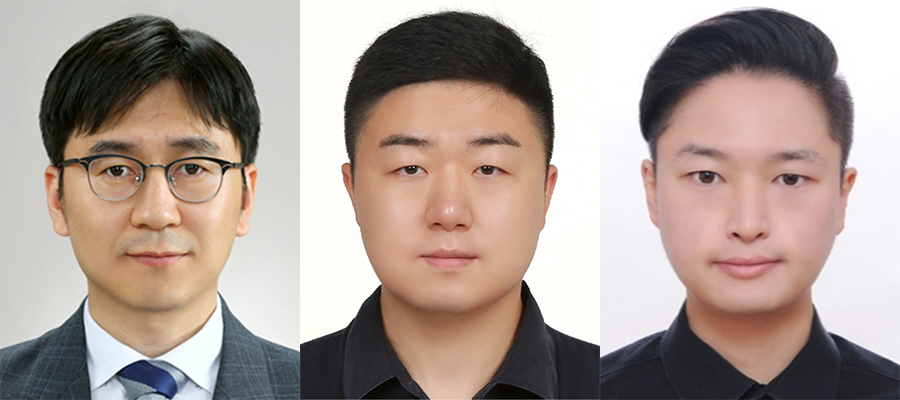커뮤니티
부경투데이
- 국립 부경대학교의 다양한 모습과 소식을 접하시면 부경대학교가 한번 더 가까워집니다.
| 英왕립화학회 저널에 연구 실렸다(Research Published in the UK Royal Society of Chemistry Journal) | |||
| 작성자 | 대외협력과 | 작성일 | 2024-12-16 |
| 조회수 | 458 | ||
| 英왕립화학회 저널에 연구 실렸다(Research Published in the UK Royal Society of Chemistry Journal) | |||||
 |
대외협력과 |  |
2024-12-16 |  |
458 |
국립부경대 연구팀, 전고체전지 음이온 분리 현상 발견
- 정성철 교수팀 연구 결과 … 영국 왕립화학회 국제학술지 게재
- 국부적인 음이온 분리 현상이 높은 이온전도도 야기해

△ 연구팀(왼쪽부터 정성철, 이세호, 전태곤) 사진.
국립부경대학교(총장 배상훈)는 정성철 교수(물리학과) 연구팀이 전고체전지에 사용되는 아지로다이트(Argyrodite) 구조의 Li6PS5Cl 계열 고체전해질에서 일가음이온과 이가음이온들이 국부적으로 분리되는 현상을 발견했다고 밝혔다.
정성철 교수와 이세호 박사후연구원(G-램프사업단), 전태곤 박사과정생(물리학과)이 주도한 연구팀은 제일원리계산을 통해 Li6-xPS5-xClBrx 고체전해질에서 발견된 음이온 국부 분리로 인한 음이온 영역에 따른 리튬 이동도의 차이가 Li6PS5Cl 계열 고체전해질의 높은 이온전도도의 원인이라는 사실을 밝혔다.
아지로다이트 구조를 기반으로 한 고체전해질은 이온전도도가 우수하고, 원재료의 경제성이 좋고 합성이 쉬워 관련 연구들이 활발하게 수행되고 있다.
정 교수팀은 이번 연구에서 리튬이온들이 Cl- 및 Br- 일가음이온 영역보다 S2- 이가음이온 영역에 더 많이 분포해 아지로다이트 구조가 효과적으로 안정화됨을 밝혔다. 또 이가음이온 영역에 분포하는 리튬이온들은 음이온과의 결합이 강해 낮은 이동도를 보이는 반면, 일가음이온 영역에 분포하는 리튬이온들은 음이온과의 결합이 상대적으로 약해서 높은 이동도를 보임을 확인했다. 이를 통해 음이온 영역에 의존하는 리튬의 이동도가 아지로다이트 고체전해질의 리튬확산 메커니즘임을 규명했다.
정성철 교수는“이번 연구를 통해 Li6PS5Cl 계열 아지로다이트 고체전해질에서 잘 알려진 음이온들의 무질서한 배열이 사실은 음이온들의 국부적인 분리 현상과 연관돼 있고, 이는 아지로다이트 고체전해질의 높은 전도도의 원인을 이해하는 새로운 관점을 제공한다.”라고 밝혔다.
한편 이번 연구는 교육부의 G-LAMP사업의 지원을 통해 진행됐으며, 영국 왕립화학회(Royal Society of Chemistry)에서 발간하는 화학?물리?재료 분야의 저명 국제학술지 <Journal of Materials Chemistry A>(IF=10.8)에 최근 게재됐다. <부경투데이>

△ Li6PS5Cl 계열 고체전해질의 음이온 분리와 그로 인한 전도도 향상 그래프.
Pukyong National University Research Team Discovers Anion Separation Phenomenon in All-Solid-State Batteries
-Research by Professor Jeong Seong-cheol’s Team Published in the UK Royal Society of Chemistry Journal
-Localized Anion Separation Phenomenon Causes High Ionic Conductivity
Pukyong National University (President Bae Sang-hoon) announced that Professor Jeong Seong-cheol’s (Department of Physics) research team discovered a phenomenon in which monovalent and divalent ions are locally separated in the Li6PS5Cl solid electrolyte of the argyrodite structure used in all-solid-state batteries.
The research team, led by Professor Jeong Seong-cheol, Postdoctoral Researcher Lee Se-ho (G-LAMP Project), and Ph.D. student Jeon Tae-gon (Department of Physics), revealed through first-principles calculations that the difference in lithium mobility due to the anion domain caused by the anion local separation discovered in the Li6-xPS5-xClBrx solid electrolyte is the cause of the high ion conductivity in the Li6PS5Cl series solid electrolytes.
Solid electrolytes based on the argyrodite structure have excellent ion conductivity, good cost-effectiveness of raw materials, and ease of synthesis, leading to active research in this field.
Professor Jung’s team found that in this study, lithium ions are more concentrated in the S2- divalent anion region than in the Cl- and Br- monovalent anion regions, leading to the effective stabilization of the argyrodite structure. Additionally, lithium ions in the divalent anion region showed low mobility due to their strong binding with the anions, while lithium ions in the monovalent anion region exhibited higher mobility due to weaker binding with the anions. Through this, they identified that the lithium diffusion mechanism in argyrodite solid electrolytes relies on the anion regions.
Professor Jung Seong-cheol stated, “This study reveals that the well-known disordered arrangement of anions in Li6PS5Cl-based argyrodite solid electrolytes is actually related to the local separation of anions, providing a new perspective for understanding the high conductivity of argyrodite solid electrolytes.”
Meanwhile, this research was conducted with support from the Ministry of Education’s G-LAMP project and was recently published in the prestigious international journal <Journal of Materials Chemistry A>(IF=10.8) by the UK Royal Society of Chemistry, which covers the fields of chemistry, physics, and materials science. <Pukyong Today>